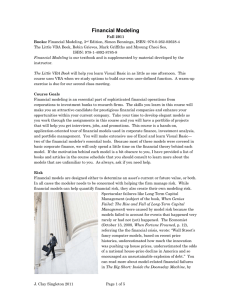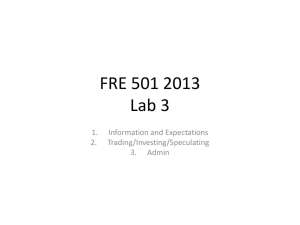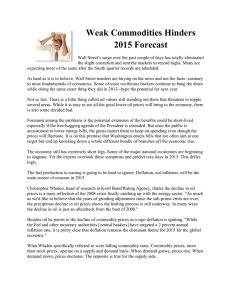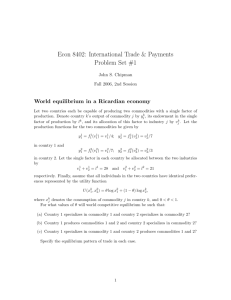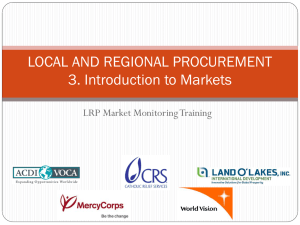UNCTAD Multi-Year Expert Meeting on Commodities and Development 2013
advertisement
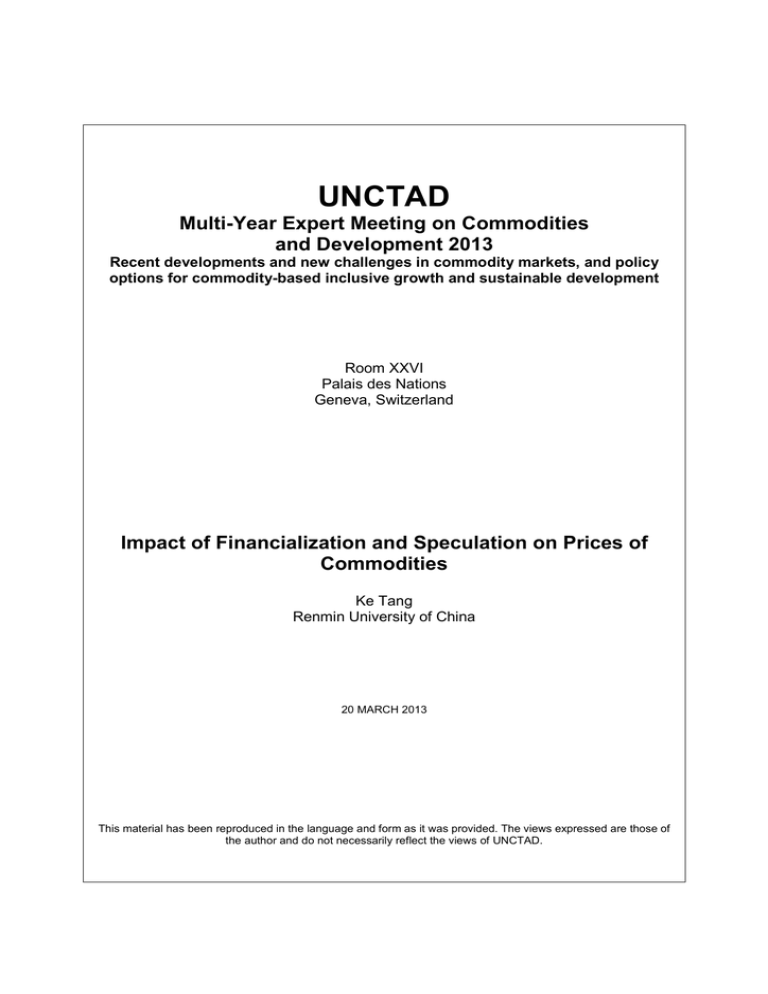
UNCTAD Multi-Year Expert Meeting on Commodities and Development 2013 Recent developments and new challenges in commodity markets, and policy options for commodity-based inclusive growth and sustainable development Room XXVI Palais des Nations Geneva, Switzerland Impact of Financialization and Speculation on Prices of Commodities Ke Tang Renmin University of China 20 MARCH 2013 This material has been reproduced in the language and form as it was provided. The views expressed are those of the author and do not necessarily reflect the views of UNCTAD. Impact of Financialization and Speculation on Prices of Commodities Ke Tang Renmin University of China Multi-year Expert Meeting, UNCTAD March 20, 2013 The Market Growth 2 Commodities as a New Asset Class Prior to early 2000s, commodities were segmented from the broader financial markets and from each other. Motivation of portfolio diversification in a low interest rate period and collapse of the equities market in early 2000s made financial institutions invest into commodities. Commodity producers (mainly from emerging economy) are lack of sound and liquid financial markets. With commodity prices went up in recent years, commodity producers turned to the U.S. financial markets. Major financial institutions invested in commodity market through commodity futures indexes, commodity-linked notes and exchange traded products. 3 Commodities as a New Asset Class 4 Commodities as a New Asset Class 5 Consequence of Financialization Through investment from financial institutions and 6 individuals, commodities are gradually financialized in the recent decade. Financialization of commodities should improve the sharing of commodity price risk. Correlation (co-movement) between different commodities increases. Correlation (co-movement) between commodities and stocks increases. Shocks from oil and other financial markets spillover to nonenergy commodities through the financialization process. Average Commodity Return Correlation 0.6 Average Correlation In-index Commodity Average Correlation Off-index Commodity 0.5 0.4 0.3 0.2 0.1 0 -0.1 72 7 75 77 80 82 85 87 90 92 95 97 00 02 05 07 10 Commodity- Stocks Correlation SP500-SPGSCIER Index 0.8 Coefficient 95% Confidence Level 0.6 Correlation 0.4 0.2 0 -0.2 -0.4 -0.6 88 8 90 92 94 96 98 00 Time 02 04 06 08 10 12 Volatility of Oil and Non-Energy Commodity Index 9 Speculators Activity-1 Oil 0.9 Speculators Hedgers Small Traders 0.8 0.7 0.6 0.5 0.4 0.3 0.2 0.1 0 1992 10 1995 1997 2000 2002 2005 2007 2010 2012 Speculators Activity-2 Copper 0.8 Speculators Hedgers Small Traders 0.7 0.6 0.5 0.4 0.3 0.2 0.1 0 1992 11 1995 1997 2000 2002 2005 2007 2010 2012 Speculators Activity-3 Wheat 0.7 0.6 0.5 0.4 0.3 Speculators Hedgers Small Traders 0.2 0.1 0 1992 12 1995 1997 2000 2002 2005 2007 2010 2012 Speculators Activity-4 Coffee 0.7 0.6 0.5 0.4 0.3 Speculators Hedgers Small Traders 0.2 0.1 0 1992 13 1995 1997 2000 2002 2005 2007 2010 2012 Behavior of Speculators and Hedgers Hedgers: producers, are contrarian traders. Speculators: institutional investors, are momentum (positive feedback) traders. 14 Speculation and Liquidity The theory of normal backwardation: Hedgers sell commodity futures to hedge their physical position, thus consume liquidity. Speculators provide liquidity to the market by offsetting hedger’s position, thus speculators make market liquid. Researchers on liquidity: Contrarian traders (hedgers) provide liquidity to the market. Momentum traders and institutional investors (speculators) consume liquidity. 15 Speculation and Liquidity By doing empirical test, my recent study shows: Speculators consume liquidity. They might drive commodity prices off its fundamental and form bubbles. Speculators destabilize prices. Hedgers provide liquidity, stabilize prices. Speculators impact prices and pay liquidity premium to hedgers. In other markets (for example the FX market), researchers show that speculation is stabilizing at low levels and destabilizing at high levels. 16 Working’s T index measure whether speculation was excessive in commodity market. 1.45 Working's T Index for WTI Crude Oil 1.4 1.35 1.3 1.25 1.2 1.15 1.1 1.05 1 92 17 95 97 00 02 05 07 10 12 Conclusion Speculators and index traders are mainly financial institutional investors, their risk attitude, capital constraints, leverage etc. will influence their participation in the market, and hence the market prices. Speculators offset trades of hedgers, but too many (large) speculators dry up the market liquidity and destabilize the prices. Position limit and higher margin requirement are appropriate ways to curb too much speculation. 18

